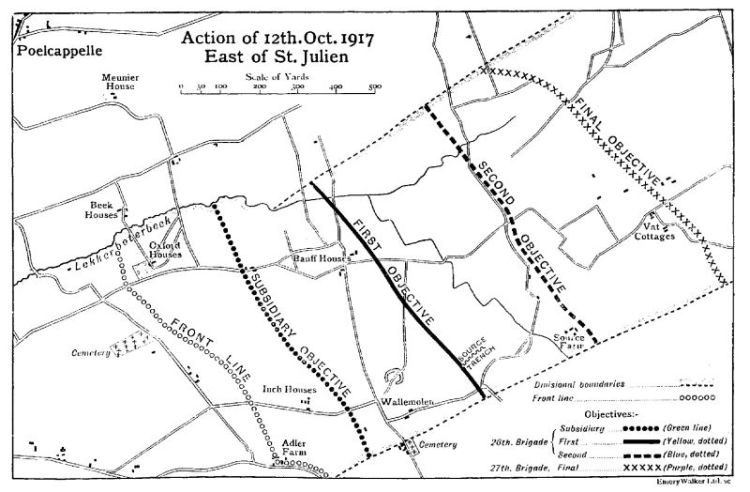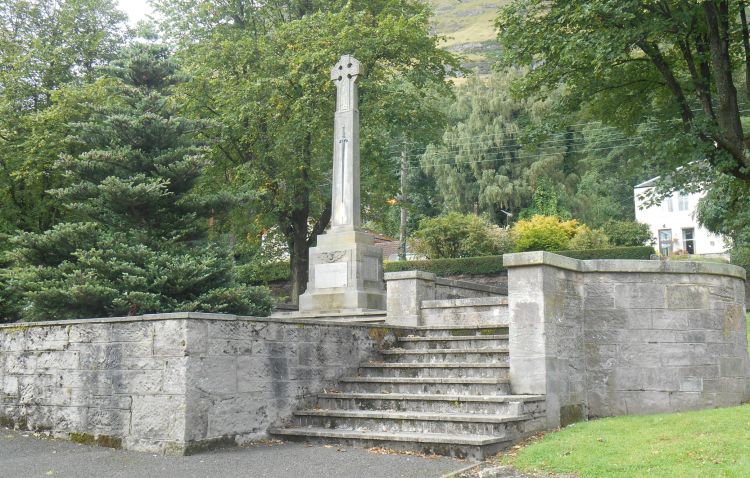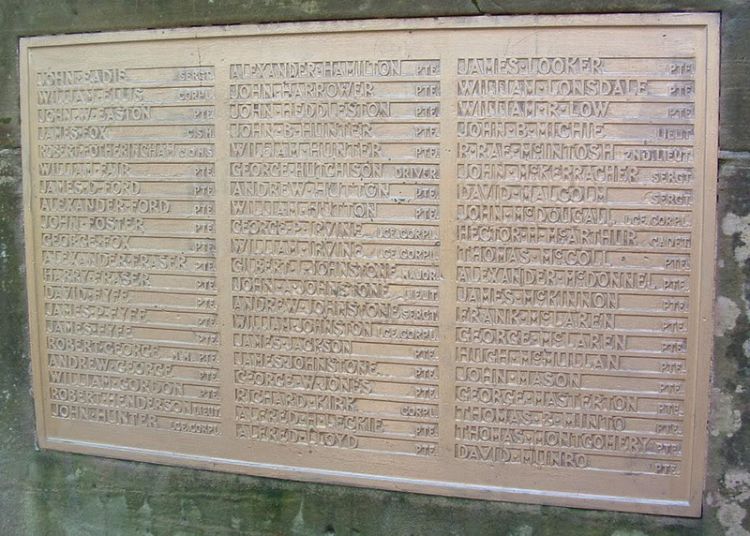Private George Masterton
S/8476, 8th Battalion The Black Watch
(Royal Highlanders)
(Royal Highlanders)
killed in action 12th October 1917
aged 29
Tyne Cot Memorial. Panels 94 to 96.
Alva War Memorial
son of John Masterton and Mary Brember, Alva, Clackmannanshire
husband of Mary Campbell
aged 29
Tyne Cot Memorial. Panels 94 to 96.
Alva War Memorial
son of John Masterton and Mary Brember, Alva, Clackmannanshire
husband of Mary Campbell
Genealogy
George Masterton was born in Alva, Clackmannanshire, Scotland before 19 July 1888, the third child born to John Masterton, a wool weaver, and Mary Brember who had married in Alva in 1870. He married Mary Campbell on 19 July 1912 in Alva, at which time he was a Burgh Scavenger. George was enlisted into the Royal Highlanders (Black Watch), service number S/8476. After George's death, his widow married a McKenzie. Further details of George and the extended family of Mastertons who can be traced back to the Culross area of Fife can be found at the following link.
His War
The 8th (Service) Battalion Black Watch (Royal Highlanders), was a battalion of the New Armies, formed in Perth on 21 August 1914, as part of K1 under command of 26th (Highland) Brigade in the 9th (Scottish) Division. Initial training was at Aldershot, then later (January 1915) at Alton and in March to Bordon. It landed at Boulogne on 10 March 1915. It took part in the Battles of Loos, the Somme, Arras, Third Ypres (Passchendaele), the German Spring Offensive and the Final Advance. It came to be recognised as one of the most effective fighting forces in the British Army.
George did not receive the 1915 Star Medal so he cannot have joined the battalion until 1916 at the earliest.
In October 1917, the battalion was holding the line in Belgium. The Unit War Diaries of the period describe the fighting between 10th and 14th October 1917 including a major attack east of St. Julien on the 12th October as part of the Battle of Passchendaele. Private George Masterton was assumed killed in action on 12th October 1917, one of the 88 Other Ranks posted missing in the brutal fighting in atrocious conditions, and he is remembered on the Tyne Cot Memorial.
The History of the Ninth (Scottish) Division.
The scene of battle was the low, flat country near the northern end of the Passchendaele Ridge. Along the left boundary of the Division ran the Lekkerboterbeek stream, and though the whole area was studded with fortified farms and houses, there were no clear landmarks. ..There were three objectives; the first two (the Yellow Dotted and the Blue Dotted Lines) were to be taken by the Highland Brigade, and the final one (the Dotted Purple Line( by the Lowland. The leading battalions of the 26th, the Black Watch and the Argylls, each on a two-company front, were to capture a subsidiary objective (Green Line) and the Yellow Dotted Line, after which the Seaforths and Camerons were to pass through and go on to the Blue Dotted Line, while the final attack was allotted by Brig.-General Croft to the 13th and 11th Royal Scots. The assault was on a very wide frontage for a brigade, and necessitated considerable gaps between sections. The barrage was to move at the rate of 100 yards every eight minutes, with a pause on the first and second objectives, and 16 Vickers Guns were to form a machine-gun barrage and were also to support the infantry with covering fire. On the flanks of the Ninth the attack was to be carried on by the New Zealand Division on the right and the Eighteenth Division on the left. Zero was 5.35 A.M.

About midnight on the 11th, the weather broke down completely. and the march of the battalions of the 27th Brigade under torrents of rain along the slippery duckboards to their assembly positions was one prolonged ordeal. The forming-up positions were heavily barraged with gas and H.E. by the enemy's guns; many of the taping parties were killed or wounded, and all had to wear their respirators for several hours. The assembly was in consequence a difficult matter, and slight confusion arose before the men were placed in their correct positions.
At 5.35 A.M. our barrage opened, but was thin and ragged. The leading men lost direction almost at once, owing to the wide frontage and the execrable conditions of the ground. The right company of the Black Watch, by the aid of skilful Lewis Gun and rifle-fire, rushed Adler Farm, captured several prisoners, and though some casualties were sustained reached its objective on the Green Line. But the left company ran into our own barrage, and inclining to the left, made a gap between it and the right company; it was under fire the whole way and was compelled to dog-in a few hundred yards in front of our original line. The company, which was to pass this one on the Green Line, also swung to the left to such an extent that it came up on the left of the leading company; from the very commencement it was in trouble, and its commander and H.Q. were all knocked out in an attempt to rush a "Pill-box." Meantime the right rear company, passing through its front one, reached Source Trench near the Yellow Dotted Line.
The first company of the Seaforths, sadly depleted by fire from parties of Germans in organised shell-holes, advanced and filled the space between the two leading ones of the Black Watch. The 13th Royal Scots, following close behind, became mingled with the Seaforths. There was some opposition from Inch Houses, and in numerous cases clusters of Germans offered resistance until they were taken in flank; in one case two of our sergeants, both of whom had been wounded, charged a group of nine and killed every one. Small parties of our men were seen in dim light to pass Banff Houses and Source Trench, and some may even have entered the eastern end of Wallemolen, but being heavily enfiladed from both flanks had to fall back on the Cemetery-Inch Houses line...
..Except on the extreme right the advance had come to a halt about 100 yards from the starting-point. The New Zealanders on our right flank had made some progress, but the Eighteenth Division, as was the case with our left battalion, had been handicapped by the spongy nature of the ground and was back in its original position. Several unfortunate men had been drowned in the deep, water-filled shell holes, and rifles and machine-guns were clogged with slime. The barrage having gone far ahead, nothing was to be gained by persisting in the attack, and the line taken up by the Ninth at the close of the battel ran from the Cemetery near Wallemolen in front of Inch Houses, thence to the Oxford Houses and back to our original front system...
...Rain and mud constitute the chief explanation for the failure of the Division in this battle, which should not have been fought; no man could progress at more that a snail's pace, and sheer exhaustion was a factor more potent than the enemy in bringing the advance to a standstill. The breakdown in communications was understandable and largely unavoidable, since the pigeons were unable to fly against the strong wind that prevailed, and the men who had charge of the messenger dogs all became casualties. The barrage was not up to the usual standard of the Divisional Artillery, but its lack of density and its raggedness were due to the short period that had elapsed since the last action and to the weather. Many of the guns stuck in the mud, all the men were dead-beat, and Brig.-General Tudor could not get the quantity of the smoke-shells he wanted. Since the horses could not leave the roads, it was only by means of light railways that field-guns could be brought into action off the roads and supplied with ammunition...
...Possibly heroism on a grander scale has never been shown than in the brutal fighting on the foul quagmires of Flanders. Often neck-deep in mud, the men floundered forward until their overtaxed limbs could no longer support them, and to wrest victory under such appalling conditions was a task beyond the power of man.
The History of the Ninth (Scottish) Division. 1914-1919.
John Ewing,
John Murray, Albemarle Street, London
1921
Unit War Diary: 8th Battalion, Black Watch
9/10/17: Battalion in SIEGE CAMP. Preparations being made to take over the line.
10/10/17 to 14/10/17: See Narrative attached. Casualty lists also attached.
14/10/17: Relief of Battalion carried out without casualties by units of 27th Brigade & Battalion proceeded to billets at SIEGE CAMP.
Our total casualties were - Killed - Officers 3, O.R.s 40.
Wounded - Officers 4, O.R.s 166 (1 Officer died of Wds.)
Missing - Officers nil O.R.s 88.
Total - 7 Officers & 294 O.R.s
National Archives
Kew, London
WO 95/1766/2
26 Infantry Brigade: 8 Battalion Black Watch (Royal Highlanders)
May 1917 - Dec 1917
The Scotsman
MISSING:- THE BLACK WATCH.-...Masterton, 8476, G. (Alva);...
The Scotsman
Edinburgh
27 November 1917
His home town of Alva remembers George on its War Memorial


George is fourth from the bottom of the third column.
Other Sources
- Commonwealth War Graves Commission
- Scottish National War Memorial
- Soldiers Died in the Great War, 1914-1919. George Masterton
- Unit War Diary 8 Black Watch: WO 95/1766/2. Narrative of Operations Undertaken by 8th Black Watch during period 10th - 14th October, 1917.
Page 1; Page 2; Page 3; Page 4; Page 5; Page 6; Page 7; Page 8; Page 9. - George Masterton Medal Roll Index Card
- George Masterton Medal Roll
- George Masterton in IWM Lives of First World War
- Medals: Victory, British War.